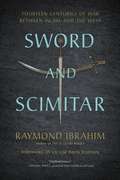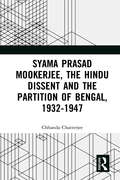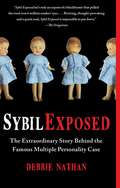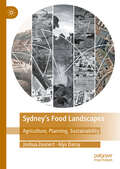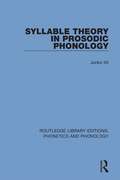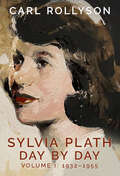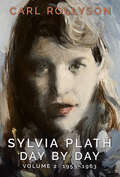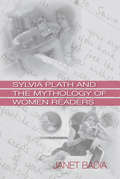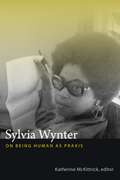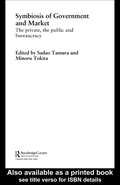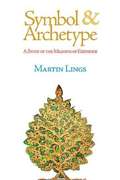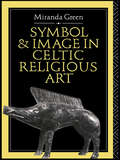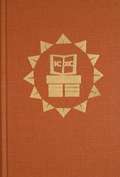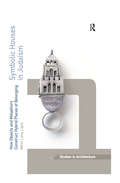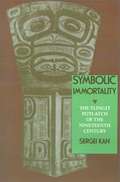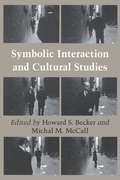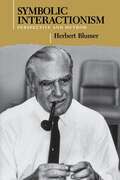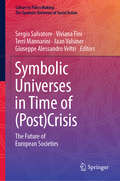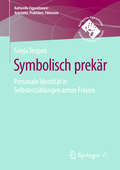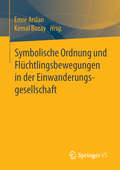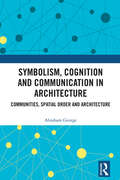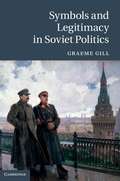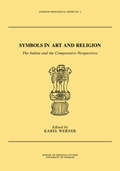- Table View
- List View
Sword and Scimitar: Fourteen Centuries of War between Islam and the West
by Victor Davis Hanson Raymond IbrahimA sweeping history of the often-violent conflict between Islam and the West, shedding a revealing light on current hostilities The West and Islam--the sword and scimitar--have clashed since the mid-seventh century, when, according to Muslim tradition, the Roman emperor rejected Prophet Muhammad's order to abandon Christianity and convert to Islam, unleashing a centuries-long jihad on Christendom. Sword and Scimitar chronicles the decisive battles that arose from this ages-old Islamic jihad, beginning with the first major Islamic attack on Christian land in 636, through the Muslim occupation of nearly three-quarters of Christendom which prompted the Crusades, followed by renewed Muslim conquests by Turks and Tatars, to the European colonization of the Muslim world in the 1800s, when Islam largely went on the retreat--until its reemergence in recent times. Using original sources in Arabic and Greek, preeminent historian Raymond Ibrahim describes each battle in vivid detail and explains how these wars and the larger historical currents of the age reflect the cultural fault lines between Islam and the West. The majority of these landmark battles--including the battles of Yarmuk, Tours, Manzikert, the sieges at Constantinople and Vienna, and the crusades in Syria and Spain--are now forgotten or considered inconsequential. Yet today, as the West faces a resurgence of this enduring Islamic jihad, Sword and Scimitar provides the needed historical context to understand the current relationship between the West and the Islamic world--and why the Islamic State is merely the latest chapter of an old history.
Syama Prasad Mookerjee, the Hindu Dissent and the Partition of Bengal, 1932-1947
by Chhanda ChatterjeeThis study on Dr. Syama Prasad Mookerjee will help the readers understand the circumstances under which he assumed the leading role in the carving out the province of West Bengal from the littoral that was soon to become the province of East Pakistan.The role of Dr. Syama Prasad Mookerjee in demanding the separation of the Hindu majority districts in the western half of Bengal from the proposed East Pakistan has not been studied so far or documented. The ‘Right’ historians today try to view it as a great triumph for the Hindus while ‘Secular’ ones try to paint Syama Prasad as an ‘arch communalist’. Underlying both versions of the story is an assumption that the partition of Bengal was a much sought after goal pursued by Syama Prasad. Yet an impassioned examination of the actual documents show that Syama Prasad tried to work out a formula for the co-existence of the Hindus and the Muslims till the very last.Only when all attempts, including that of Mahatma Gandhi in the dark days of the Noakhali riots, failed to dissuade the Muslim League from trying to push the subcontinent towards partition that Syama Prasad launched his drive for the separation of the western districts of Bengal from East Pakistan. Partition was the bane of the Hindu Mahasabha. They had called a hartal on 3 July 1947 to register their disapproval of the idea. But once partition gained acceptance at all levels, beginning from the Congress to the Viceroy Lord Mountbatten, Syama Prasad saw no alternative to making the best of a bad bargain and pushed for partition.The bloodbath of 16 August 1946 in Calcutta and the reprehensible violation of Hindu women in Noakhali the following October cast the die. He took a leaf out of Master Tara Singh's plans in the Punjab for the regrouping of the provinces by isolating the non-Muslim population from the Muslim majority zones. The Congress Working Committee took the same line passing a resolution on 8 March 1947 in favour of the isolation of the non-Muslim areas in the Punjab from the predominantly Muslim ones. This strengthened Syama Prasad’s case for the partition of Bengal. However, this was a last resort measure failing all other options. Please note: This title is co-published with Manohar Publishers, Delhi. Taylor & Francis does not sell or distribute the Hardback in India, Pakistan, Nepal, Bhutan, Bangladesh and Sri Lanka.
Sybil Exposed: The Extraordinary Story Behind the Famous Multiple Personality Case
by Debbie NathanNow available in paperback, Sybil Exposed is the New York Times bestselling book that offers a new perspective on the smash hit book and film, Sybil, and on multiple personality disorder itself. Sybil: a name that resonates with legions of obsessed fans who followed the nonfiction blockbuster from 1973. The book rocketed multiple personality disorder into public consciousness and played a major role in having the diagnosis added to the psychiatric bible, Diagnostic and Statistical Manual of Mental Disorders. But what do we really know about how Sybil came to be? In her news-breaking book Sybil Exposed, journalist Debbie Nathan gives proof that the allegedly true story outlined in the megabestseller was largely fabricated. The actual identity of Sybil (Shirley Mason) has been available for some years, as has the idea that the book might have been exaggerated. But Nathan reveals the trio of women behind the legend: the willing patient, her ambitious shrink, and the imaginative journalist who spun their story into bestseller gold. Sybil Exposed draws from an enormous trail of papers, records, photos, and tapes to unearth the lives and passions of these three women whose story exploded into an epic movement with consequences beyond their wildest dreams. Set across the twentieth century and rooted in a time when few professional roles were available to women, this is a story of corrosive sexism, bold but unchecked ambition, runaway greed, utter human vulnerability, duplicity and shared delusion, shaky theories of psychoanalysis exuberantly and drastically practiced, and how one modest young woman’s life turned psychiatry on its head and radically changed the course of therapy—and our culture, as well.
Sydney’s Food Landscapes: Agriculture, Planning, Sustainability
by Joshua Zeunert Alys DaroyThe story of Sydney’s metropolitan food landscapes is one of dramatic transformations of First Nations land amidst jostles for power and wealth. This book unearths Sydney's lost commercial agriculture since colonisation in 1788 to assess its fragile food futures. Richly illustrated, 270 images are encapsulated within 110 figures, including an array of original metropolitan-scale mappings. Discussion traverses the city’s diverse cultural influences, from Indigenous land management to British pastoralism, Chinese cultivation of Sydney’s “backyard vegetable garden” and southern European farming spawning billion-dollar empires. The region has further been shaped by a vast array of cultural and ideological factors and material practices, with relevance to planning, policy, ethics, geography, heritage, art, design and technology. This book is the first to bring Sydney’s disparate post-colonial food histories together in one volume to explore the dynamics and tensions between urban growth and food production. The relevance of Sydney’s food landscapes therefore extends far wider than the city itself, with implications for countless regions worldwide in a time of increasing climate and resource precarity.
Syllable Theory in Prosodic Phonology (Routledge Library Editions: Phonetics and Phonology #10)
by Junko ItôFirst published in 1988. The goal of this study is to explore the workings of a syllable theory which is an integral part of Prosodic Phonology. It will be shown that theory-internal considerations and a variety of empirical arguments converge on a conception of syllabification as continuous template matching governed by syllable wellformedness conditions and a directional parameter. This title will be of interest to students of language and linguistics.
Sylvia Plath Day by Day, Volume 1: 1932-1955
by Carl RollysonSince Sylvia Plath’s death in 1963, she has become the subject of a constant stream of books, biographies, and articles. She has been hailed as a groundbreaking poet for her starkly beautiful poems in Ariel and as a brilliant forerunner of the feminist coming-of-age novel in her semiautobiographical The Bell Jar. Each new biography has offered insight and sources with which to measure Plath’s life and influence. Sylvia Plath Day by Day, a two-volume series, offers a distillation of this data without the inherent bias of a narrative.Volume 1 commences with Plath’s birth in Boston in 1932, records her response to her elementary and high school years, her entry into Smith College, and her breakdown and suicide attempt, and ends on February 14, 1955, the day she wrote to Ruth Cohen, principal of Newnham College, Cambridge, to accept admission as an “affiliated student at Newnham College to read for the English Tripos.” Sylvia Plath Day by Day is for readers of all kinds with a wide variety of interests in the woman and her work. The entries are suitable for dipping into and can be read in a minute or an hour. Ranging over several sources, including Plath’s diaries, journals, letters, stories, and other prose and poetry—including new material and archived material rarely seen by readers—a fresh kaleidoscopic view of the writer emerges.
Sylvia Plath Day by Day, Volume 2: 1955-1963
by Carl RollysonSince her death in 1963, Sylvia Plath has become an endless source of fascination for a wide audience, ranging from readers of The Bell Jar, her semiautobiographical novel, to her groundbreaking poetry as exemplified by Ariel. Beyond her writing, however, interest in Plath was also fueled in part by the nature of her death—a suicide while she was estranged from her husband, Ted Hughes, who was himself a noteworthy British poet. As a result, a steady stream of biographies of Plath, projecting an array of points of view about their subject, has appeared over the last fifty-five years. Now biographer Carl Rollyson, the author of two previous biographical studies of Plath, has surveyed the vast amount of material on Plath, including her biographies, her autobiographical writings, and previously unpublished material, and distilled that data into the two volumes of Sylvia Plath Day by Day. As the follow-up to volume 1, volume 2 commences on February 14, 1955, the day Plath wrote to her mother declaring her intention to study in England, a decision that marked a major turning point in her life. With brief signposts provided by the author, this volume follows Plath through the entirety of her marriage to Hughes, the challenges of simultaneously raising a family and nourishing her own creativity, and the major depressive episodes that ultimately led to her suicide in 1963. By providing new angles and perspectives on the life of one of the twentieth century’s most celebrated poets, Sylvia Plath Day by Day offers a comprehensive image of its enigmatic subject.
Sylvia Plath and the Mythology of Women Readers
by Janet BadiaDepicted in popular films, television series, novels, poems, and countless media reports, Sylvia Plath's women readers have become nearly as legendary as Plath herself, in large part because the depictions are seldom kind. If one is to believe the narrative told by literary and popular culture, Plath's primary audience is a body of young, misguided women who uncritically--even pathologically--consume Plath's writing with no awareness of how they harm the author's reputation in the process. Janet Badia investigates the evolution of this narrative, tracing its origins, exposing the gaps and elisions that have defined it, and identifying it as a bullying mythology whose roots lie in a long history of ungenerous, if not outright misogynistic, rhetoric about women readers that has gathered new energy from the backlash against contemporary feminism. More than just an exposé of our cultural biases against women readers, Badia's research also reveals how this mythology has shaped the production, reception, and evaluation of Plath's body of writing, affecting everything from the Hughes family's management of Plath's writings to the direction of Plath scholarship today. Badia discusses a wide range of texts and issues whose significance has gone largely unnoticed, including the many book reviews that have been written about Plath's publications; films and television shows that depict young Plath readers; editorials and fan tributes written about Plath; and Ted and (daughter) Frieda Hughes's writings about Plath's estate and audience.
Sylvia Wynter: On Being Human as Praxis
by Katherine MckittrickThe Jamaican writer and cultural theorist Sylvia Wynter is best known for her diverse writings that pull together insights from theories in history, literature, science, and black studies, to explore race, the legacy of colonialism, and representations of humanness. Sylvia Wynter: On Being Human as Praxis is a critical genealogy of Wynter's work, highlighting her insights on how race, location, and time together inform what it means to be human. The contributors explore Wynter's stunning reconceptualization of the human in relation to concepts of blackness, modernity, urban space, the Caribbean, science studies, migratory politics, and the interconnectedness of creative and theoretical resistances. The collection includes an extensive conversation between Sylvia Wynter and Katherine McKittrick that delineates Wynter's engagement with writers such as Frantz Fanon, W. E. B. DuBois, and Aimé Césaire, among others; the interview also reveals the ever-extending range and power of Wynter's intellectual project, and elucidates her attempts to rehistoricize humanness as praxis.
Symbiosis of Government and Market: The Private, the Public and Bureaucracy
by Sadao Tamura Minoru TokitaIn this volume, a group of international scholars address issues relating to community wellbeing and the role of politics, law and economics in Europe and Japan in achieving human-centred symbiotic governance. Case-studies and suggestions for reform are presented in the arenas of economy, government administration, management, university governance, health, agriculture, the environment and urban planning.This book will prove a useful tool to those in business research institutes, members of administrative research institutes, NGO's and non-profit organizaions while also providing students of business, Asian studies, politics and law with an insight into possible areas of reform.
Symbol and Archetype: A Study of the Meaning of Existence
by Martin LingsEvery religious tradition or metaphysical worldview involves a system of powerful symbols, most of which bear common meanings across cultures, continents, and time. This volume, complete with a 9th century Quranic manuscript, explores the significance of the most recurrent symbols and archetypes in human history and elaborates a compelling theory for why symbolism plays such an essential role in human life. The work explores certain basic aspects of symbolism in relation to the Divinity, the hierarchy of the universe, the function of human faculties and qualities, the human condition, natural objects, works of art, and the final end--all with reference to the great living religions of the world, and in particular to Christianity and Islam.
Symbol and Image in Celtic Religious Art
by Miranda GreenFirst published in 1992. Routledge is an imprint of Taylor & Francis, an informa company.
Symbol and Sacrament: A Sacramental Reinterpretation of Christian Existence
by Louis-Marie ChauvetChauvet charts a reorientation in sacramental theology from the scholastic treatments. In this approach the subject is as much "grasped" by the symbolic representation as is the object being interpreted.
Symbolic Houses in Judaism: How Objects and Metaphors Construct Hybrid Places of Belonging (Ashgate Studies in Architecture)
by Mimi Levy LipisInvestigating Jewish spatial practices by exploring the symbol of the house in Judaism, this book examines two groups of houses: ritual objects based on the iconology of the house (ritual houses) and house metaphors (the text, community and the covenant with god as house). This unique pairing is explored as place-making tools which exist in a constant state of tension between diaspora and belonging. Containing many photographs of historical and contemporary artefacts from Europe, Israel and the United States, this book maps out the intersection of architecture, Jewish studies, cultural and gender studies and opens up the discussion of distinctly Jewish objects and metaphors to discourses taking place outside explicitly Jewish contexts.
Symbolic Immortality: The Tlingit Potlatch Of The Nineteenth Century
by Sergei KanWinner of the 1990 American Book Award of the Before Columbus Foundation. The first comprehensive analysis of the mortuary practices of the Tlingit Indians of Southeastern Alaska.
Symbolic Interaction and Cultural Studies
by Becker, Howard S. and McCall, Michal M.Symbolic interactionism, resolutely empirical in practice, shares theoretical concerns with cultural studies and humanistic discourse. Recognizing that the humanities have engaged many of the important intellectual currents of the last twenty-five years in ways that sociology has not, the contributors to this volume fully acknowledge that the boundary between the social sciences and the humanities has begun to dissolve. This challenging volume explores that border area.
Symbolic Interaction and Cultural Studies
by Becker, Howard S. and McCall, Michal M.Symbolic interactionism, resolutely empirical in practice, shares theoretical concerns with cultural studies and humanistic discourse. Recognizing that the humanities have engaged many of the important intellectual currents of the last twenty-five years in ways that sociology has not, the contributors to this volume fully acknowledge that the boundary between the social sciences and the humanities has begun to dissolve. This challenging volume explores that border area.
Symbolic Interactionism: Perspective and Method
by Herbert BlumerThis is a collection of articles dealing with the point of view of symbolic interactionism and with the topic of methodology in the discipline of sociology. It is written by the leading figure in the school of symbolic interactionism, and presents what might be regarded as the most authoritative statement of its point of view, outlining its fundamental premises and sketching their implications for sociological study. Blumer states that symbolic interactionism rests on three premises: that human beings act toward things on the basis of the meanings of things have for them; that the meaning of such things derives from the social interaction one has with one's fellows; and that these meanings are handled in, and modified through, an interpretive process.
Symbolic Universes in Time of: The Future of European Societies (Culture in Policy Making: The Symbolic Universes of Social Action)
by Jaan Valsiner Sergio Salvatore Viviana Fini Terri Mannarini Giuseppe Alessandro VeltriThis book investigates whether, how and where the cultural milieu of European societies has changed as a result of the socio-economics crisis. To do so, it adopts a psycho-cultural approach, which views the cultural milieu as a set of meanings, placing the generalized image social actors have of themselves, the world, events and their relationships in the context of the socio-political and institutional environment, including policies. By analyzing the changes in cultural milieu and social identity, the book develops strategic and methodological guidelines for the design of post-crisis policies, providing a concept of how the cultural dynamics are associated with certain individual characteristics and specific socio-economic phenomena.
Symbolisch prekär: Personale Identität in Selbsterzählungen armer Frauen (Kulturelle Figurationen: Artefakte, Praktiken, Fiktionen)
by Sonja TeupenIm Zentrum der mikrosoziologisch und kulturpsychologisch informierten Studie steht die Subjektposition der armen Frau. Im Unterschied zu anderen Subjektpositionen geht diese nicht mit einem Versprechen sozialer Anerkennung einher, sondern erfolgt vorrangig unter Bedingungen symbolischer Prekarität. Anhand von Selbsterzählungen von Frauen in Armutslagen in Deutschland und den USA wird untersucht, wie die Erzählerinnen ihr Subjektsein narrativ verhandeln und damit personale Identität konstituieren. Die Analyse im methodologischen Rahmen der relationalen Hermeneutik rekonstruiert zwei Ebenen des Gegenstandes: Thematisch plausibilisieren die Erzählerinnen ihr Armsein entlang der Topoi Krankheit, Trennung, Kindheit und Schicksal. Strukturell sind ihre Erzählungen aufgespannt zwischen den Punkten Widerfahrnis und Handlung, Identifikation und Differenz, Zurechnung und Autonomie.Der InhaltEinführungSozial- und kulturwissenschaftliche Identitätsforschung im interpretativen ParadigmaPersonale IdentitätMethodik der Analyse personaler IdentitätFallvergleich und Typisierung: AnalyseTopik und Typologie: DiskussionSchlussDie AutorinDr. Sonja Teupen ist Wissenschaftliche Mitarbeiterin für Qualitative Methoden am Deutschen Zentrum für Neurodegenerative Erkrankungen (DZNE), Standort Witten. Im Kontext der Demenz-Versorgungsforschung arbeitet sie unter anderem zum Thema Selbst und Personsein in sozialen Beziehungen. Daneben ist sie Lehrbeauftragte des Instituts für Soziologie an der FernUniversität in Hagen.
Symbolische Ordnung und Flüchtlingsbewegungen in der Einwanderungsgesellschaft
by Kemal Bozay Emre ArslanDas Thema der Flüchtlingsbewegungen ist in den letzten Jahren vielfach in den Fokus politischer, medialer und wissenschaftlicher Diskurse gerückt. Dabei geht es sowohl um eine globale Diskussion über die Fluchtthematik als solches als auch um die Lebensbedingungen von geflüchteten Menschen in der Aufnahmegesellschaft. Gegenwärtig kann beobachtet werden, dass die Willkommensstimmung gegenüber Geflüchteten größtenteils gekippt ist, und in der politischen, institutionellen und medialen Debatte über Geflüchtete eine Tendenz zur Kriminalisierung und Skandalisierung vorherrscht. Vielfältige aktuelle Forschungen haben sich interdisziplinär mit den unterschiedlichen Aspekten der Flüchtlingsbewegungen beschäftigt. Dieser Sammelband hat sich zum Ziel gesetzt, den Bourdieuschen Diskurs zur „Symbolischen Ordnung“ auf das Themenfeld „Flüchtlingsbewegungen“ zu übertragen und zu diskutieren.
Symbolism and Regime Change in Russia
by Graeme GillDuring the Soviet period, political symbolism developed into a coherent narrative that underpinned Soviet political development. Following the collapse of the Soviet regime and its widespread rejection by the Russian people, a new form of narrative was needed, one which both explained the state of existing society and gave a sense of its direction. By examining the imagery contained in presidential addresses, the political system, the public sphere and the urban development of Moscow, Graeme Gill shows how no single coherent symbolic programme has emerged to replace that of the Soviet period. Laying particular emphasis on the Soviet legacy, and especially on the figure of Stalin, 'Symbolism and Regime Change in Russia' explains why it has been so difficult to generate a new set of symbols which could constitute a coherent narrative for the new Russia.
Symbolism, Cognition and Communication in Architecture: Communities, Spatial Order and Architecture
by Abraham GeorgeThis book discusses the role and significance of symbols and symbolism in graphical communication toward the establishment of meaningful architecture. It explores how these are effectively applied in architectural education for the empowerment of learners in various cultures around the world. The volume examines the developments in graphic representations while recognizing the importance of cognition and its perception in spatial terms. In a scenario where architectural education is at crossroads, facing challenges of a global nature, this book highlights the importance of understanding architectural curriculum and design subjects. The author discusses the issues of communicating the knowledge of architecture to heterogeneous groups of students and explains how design fields and learning in architecture can be modified through cognitive instructional methods. The book outlines the methodology to develop symbols and symbolic pedagogical tools for effective communication in architecture. The book will appeal to students, researchers, teachers and scholars of architecture, design, planning and visual communication. It will also be of interest to architects, artists, spatial designers, town planners, urban planners and professionals.
Symbols and Legitimacy in Soviet Politics
by Graeme GillSymbols and Legitimacy in Soviet Politics analyses the way in which Soviet symbolism and ritual changed from the regime's birth in 1917 to its fall in 1991. Graeme Gill focuses on the symbolism in party policy and leaders' speeches, artwork and political posters, and urban redevelopment, and on ritual in the political system. He shows how this symbolism and ritual were worked into a dominant metanarrative which underpinned Soviet political development. Gill also shows how, in each of these spheres, the images changed both over the life of the regime and during particular stages: the Leninist era metanarrative differed from that of the Stalin period, which differed from that of the Khrushchev and Brezhnev periods, which was, in turn, changed significantly under Gorbachev. In charting this development, the book lays bare the dynamics of the Soviet regime and a major reason for its fall.
Symbols in Art and Religion: The Indian and the Comparative Perspectives
by Karel WernerA thorough survey of great interest and value to scholars in this field. Contributions in this series stem from a Symposia on Indian Religions which took place over ten years (1975 to 1984). The Seventh Symposium housed in Oxford, UK in 1981 was concerned with the theme of symbolism in Indian religions and like its previous one-theme conference on mysticism, generated much interest and led to this publication.
